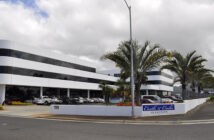
On 2 May 2013, the England and Wales Central Criminal Court sentenced James McCormick to 10 years jail for fraud. His crime was the sale of a fake bomb-detector called the ADE 651. In his closing remarks, the judge, His Honor Judge Hone QC, said of the ADE 651 and Mr. McCormick, “The device was useless, the profit outrageous and your culpability as a fraudster has to be placed in the highest category.” This paper is a case study of the ADE 651 as an example of the extreme danger pseudo-science can pose to people working in the security industry.
The ADE 651
The claims:
The Advanced Detection Equipment – 651 Remote Substance Detector was “developed” by James McCormick, founder and sole director of Advanced Tactical Security & Communications Ltd (ATSC Ltd or ATSC Ltd. UK), based out of Somerset, England in 2001. According to the ADE 651 – Frequently Asked Questions:
The ADE works on the principal we call Electro-Magnetic Attraction, EMA. The principle for long range detection is based on substance excitation that needs to be detected, with an electromagnetic field that propagates on a long distance and is not disturbed by the ” electromagnetic noise” from the environment generated by such things like RF transmitters and other electronic equipments that use electric current or electromagnetic waves…
…When the electromagnetic signal of the substance that the ADE is searching for is located within its detection range, the ADE’s receiving direction indicator, (the antenna), will move towards the direction of the existing substance. Essentially, the ADE functions like a hyper sensitive receiver. ATSC has incorporated EMA technology into its proprietary Substance Recognition Cards to specifically target either a specific substance, or group, or family of substances. For example, particularly in the case of Explosives, the Substance Recognition Card for “Plastic” can detect the family of Plastic Explosives including C4, C3, Semtex, etc.
The ADE is able to penetrate all known substances which may be used to “camouflage” the target substance because it will “lock” onto the programmed target substance only and will “bypass” any substance(s) that may be in between the target substance and the programmed ADE card. Another example could be home-made explosives such as Ammonium Nitrate whereby the ADE could not distinguish the difference between this (as an explosive) and the same as used in farm fertilizer.
In essence, the ADE functions like a hyper sensitive receiver. As the ADE receives an attraction signal from the target substance, its Indicator moves across the Operators’ body to form a 90 degree angle toward the direction of the substance.
 A hand-held, lightweight device, it was capable of operating without power sources such as batteries or mains power as it used electrostatic electricity generated by the user while he/she was in motion. One drawback of this was that the ADE 651 could not “currently be mounted in a stationary position to operate.” With a “typical 2% false positive rate”, it was able to detect substances up to 650 meters away, within less than 30 seconds and had a setup time of less than 1 minute. It was also capable of detecting substances while airborne, underground or underwater (detection ranges of up to 5000ft, 10m and 10m respectively). Physically, it resembles a bar-code scanner. Attached to the handle is a hinged panel with a telescopic antenna coming out of the base of it. An optional extra was a static meter.
A hand-held, lightweight device, it was capable of operating without power sources such as batteries or mains power as it used electrostatic electricity generated by the user while he/she was in motion. One drawback of this was that the ADE 651 could not “currently be mounted in a stationary position to operate.” With a “typical 2% false positive rate”, it was able to detect substances up to 650 meters away, within less than 30 seconds and had a setup time of less than 1 minute. It was also capable of detecting substances while airborne, underground or underwater (detection ranges of up to 5000ft, 10m and 10m respectively). Physically, it resembles a bar-code scanner. Attached to the handle is a hinged panel with a telescopic antenna coming out of the base of it. An optional extra was a static meter.
The price per unit for an ADE 651 varied from $US 2,500 to $65,000.
The Reality
The reality of the ADE 651 is one far removed from the claims and it is difficult to believe that people conceive of such devices, much less actually produce and sell them.
 The ADE 651 was based on a novelty golf-ball finder called the ‘Gopher Amazing Golf Ball Finder’ and cost less than $50.00 each to build. Instead of using “Electromagnetic attraction”, the ADE 651 worked along similar lines to divining or dowsing. The reason why the antenna would turn and point at substances or objects thought to contain substances was due to the ‘ideomotor effect.’ According to the magician and sceptic James Randi, who, in May 2008, challenged McCormick to prove the ADE 651 worked under scientific testing, the ideomotor effect is:
The ADE 651 was based on a novelty golf-ball finder called the ‘Gopher Amazing Golf Ball Finder’ and cost less than $50.00 each to build. Instead of using “Electromagnetic attraction”, the ADE 651 worked along similar lines to divining or dowsing. The reason why the antenna would turn and point at substances or objects thought to contain substances was due to the ‘ideomotor effect.’ According to the magician and sceptic James Randi, who, in May 2008, challenged McCormick to prove the ADE 651 worked under scientific testing, the ideomotor effect is:
…the psychological phenomenon that underlies dowsing, automatic writing, table tipping, and the Ouija board. Quite unconsciously, the participant is moving the hand enough to make the movement of the involved device occur, though he may attribute the motion to the divine or supernatural force in which he believes. In all these events, nothing in the way of information is revealed to the operator except what he already knows. The effect is very powerful with some personalities, and no amount of evidence will disabuse believers in the magical nature of the phenomenon.
A team at the University of Cambridge’s Computer Laboratory conducted scientific testing of the ADE 651 for BBC Newsnight during January 2010 and the results, according to Michael Sutherland, a member of the team, were that “After many trials we found that the ADE-651 device was no better than random chance at detecting explosives.” In addition, the team conducted tests on the ‘Substance Recognition Cards’ to see if there was any information stored on the cards. These cards also failed scientific tests and contained “nothing but a type of anti-theft tag used to prevent stealing in high street stores.” The ADI 651 is, as so bluntly put by Randi, a “useless, quack, device which cannot perform any other function as separating naïve persons from their money. It’s a fake, a scam, a swindle, and a blatant fraud.” The British Government banned the ADE 651 for export to Iraq and Afghanistan under the Export Control Act 2002 on 22 January 2010.
Operational History
Despite the pseudo-scientific nature of the ADE 651, the device has an extensive operational history with Governments and agencies buying over 7000 of them. Countries which purchased the ADE 651 included Iraq, Bahrain, Pakistan, Lebanon, Thailand, Kenya, Niger, Saudi Arabia and Belgium, as well as the United Nations. Images from the devices website show one detecting buried ordinance in Lebanon.
Iraq was the largest single user of the ADE 651 with purchases totalling $US85 million dollars in 2008. Following a spate of car bombings in early December 2009 that killed 127 and wounded 450, the situation ventured into the absurd when the man responsible for bringing the devices to Iraq, Maj. Gen. Jehad al-Jabri, head of the Ministry of the Interior’s General Directorate for Combatting Explosives, personally demonstrated how the device worked at a press conference. The Major General, along with two other Iraqis, later went to jail for their involvement with McCormick and the ADE-651.
In 2010, security personnel used the ADE 651 at the Jinnah International Airport, Pakistan. Following the terrorist attack there on 9 June 2014, killing 13, Dr. Sutherland asked the Pakistani Government and airport operators if the ADE 651 was still in operation there but did not get a response, promptly speculating that it was.






